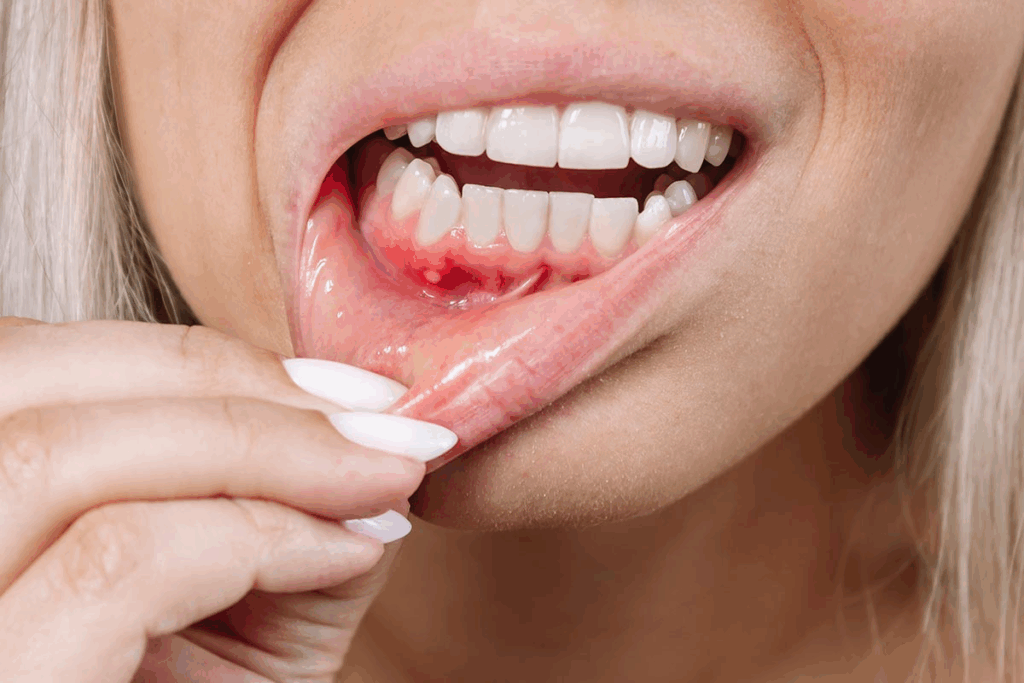Last Updated on November 27, 2025 by Ugurkan Demir

Spotting cancer under the tongue early can save lives. At Liv Hospital, we stress the need to know the signs of this aggressive oral cancer. Tongue cancer starts in the tongue’s cells, leading to lesions or tumors. What does early under tongue cancer look like? A visual guide to recognizing a small, painless, white, or red patch.
It’s vital to know what early tongue cancer looks like to get medical help fast. We focus on patient care in oral cancer screening and early detection. We use the latest research and health services to help.

Oral cancer is a big deal worldwide. It includes cancers like those on the tongue. Knowing about it is key.
We’ll look at the types of oral cancer that hit the tongue. We’ll also talk about risk factors and why catching it early is so important.
Tongue cancer usually starts in the thin cells on the tongue’s surface. Squamous cell carcinoma is the top type. Other cancers like minor salivary gland cancers and lymphomas are rarer.
Type of Cancer | Description | Prevalence |
Squamous Cell Carcinoma | Cancer that begins in the squamous cells lining the tongue | Most common type |
Minor Salivary Gland Cancers | Cancers that occur in the salivary glands under the tongue | Less common |
Lymphomas | Cancers of the immune system that can occur on the tongue | Rare |
Several things can up your risk for under tongue cancer. These include:
“The risk of developing oral cancer, including under tongue cancer, is significantly increased by the use of tobacco and excessive alcohol consumption.”
– American Cancer Society
Finding tongue cancer early is key to better treatment. Spotting signs early means quicker action. This is vital for success.
Look out for a painful lump or sore on the tongue’s side. Catching it early can greatly improve treatment chances.

Knowing the tongue’s anatomy is key to spotting cancer risks. The tongue is vital for taste, swallowing, and speech. It has parts more likely to get cancer.
The underside of the tongue, or ventral surface, is at high risk for cancer. It’s full of blood vessels and has thin skin, making it more likely to get cancer. The underside of the tongue is less visible, which can lead to delayed detection of abnormalities.
The floor of the mouth is linked closely to the tongue. It’s the area between the tongue and the lower jaw, with important structures like submandibular ducts and glands. Cancer in this area can be aggressive because of its close link to lymphatic vessels, helping cancer spread.
“The floor of the mouth is a common site for oral cancer, and its anatomy is closely linked with the tongue, making it a critical area for examination.”
The tongue frenulum, a small fold of tissue, is another high-risk area. Though rare, cancer can occur here, making early detection hard. The circumvallate papillae at the tongue’s back are also key. They have taste buds and are surrounded by a groove, a common site for cancer.
Anatomical Region | Vulnerability to Cancer | Characteristics |
Underside of the Tongue | High | Rich in blood vessels, thin mucous membrane |
Floor of the Mouth | High | Proximity to lymphatic vessels, common site for oral cancer |
Tongue Frenulum | Low to Moderate | Rare site for cancer, difficult to detect early |
Circumvallate Papillae | Moderate | Contains taste buds, surrounded by a groove |
Knowing about these areas and their cancer risks is vital for early detection and treatment. Regular checks and awareness can greatly improve patient outcomes.
Early under tongue cancer shows signs that can lead to quick diagnosis. We’ll look at color and appearance changes, and texture and surface issues. These signs can mean cancer is starting.
Early tongue cancer often shows as a change in the tongue’s underside. You might see a painful lump or sore that looks grayish-pink or red. These color changes are important to notice.
At first, tongue cancer might not hurt or show symptoms. Doctors or dentists might find it during a check-up. So, regular visits are key for catching it early.
Early tongue cancer also changes the tongue’s texture and surface. The tongue might feel uneven with lumps or sores. These can feel like hard or rough patches on the tongue.
Another sign is a cancer bruise on the tongue that doesn’t heal like a normal bruise. Watching for texture or surface changes is important. They could mean cancer is there.
Knowing these signs helps people get medical help fast if they see anything odd. Catching cancer early is vital for better treatment and results.
Knowing the early signs of tongue cancer is key to getting help fast. Early detection means better treatment chances.
Pain in the tongue or mouth is a common first sign. This pain can feel dull or sharp and get worse. It might even spread to the ear or throat.
When eating hot or cold foods, the pain can be more noticeable. It’s easy to think it’s just a minor issue. But if the pain doesn’t go away, see a doctor.
Common Pain Patterns:
Bleeding or sores that won’t heal are big warning signs. These sores bleed easily and don’t get better. A sore on the tongue that doesn’t heal is often a sign of cancer.
If you have bleeding or sores that last over two weeks, get them checked. A doctor needs to look at them.
“The presence of a non-healing sore or ulcer on the tongue is a red flag for possible cancer and needs immediate doctor’s attention.”
Symptom | Description |
Bleeding | Unexplained bleeding from the tongue or mouth |
Non-healing Sores | Sores or ulcers that last more than two weeks |
Changes in how the tongue moves or works can be a sign of cancer. As cancer grows, it can make speaking, eating, or swallowing hard. You might feel your tongue is stiff or moves less than usual.
Any change in tongue movement or function should be checked by a doctor.
Spotting tongue cancer early can greatly improve treatment success. Knowing symptoms like pain, bleeding, sores, and tongue changes helps you act fast.
Tongue cancer under the tongue can look different. A visual guide helps us understand these differences. It’s important to know the early signs for quick diagnosis and treatment.
At the early stages, tongue cancer under the tongue might show small changes. These can include:
These signs might be small, but they’re key for catching cancer early. As one expert says,
“Early detection of oral cancer is key to improving survival rates and treatment outcomes.”
As tongue cancer gets worse, the changes become more obvious. The lesions might:
It’s important to watch for any mouth changes and see a doctor if worried.
Telling benign from malignant lesions is hard without a doctor. But, some signs might point to cancer:
Seeing a healthcare professional for any oral concerns is a good idea. The American Cancer Society notes,
“Regular oral exams are key for catching oral cancers early.”
It’s important to know about the lumps and growths linked to under tongue cancer. This knowledge helps in catching the disease early and treating it well. Tongue cancer, like squamous cell carcinoma, can cause different kinds of lesions or tumors under the tongue.
These growths can look, feel, and be different in severity. It’s key to tell apart cancerous from non-cancerous causes for the right care.
A hard lump on the tongue’s side might mean oral cancer, but it’s not the only reason. Other things like trauma, infections, or benign tumors can also cause lumps.
Seeing a doctor is key to figure out what’s causing these lumps.
White bumps on the tongue can be from many things, including oral cancer. If it’s cancer, these bumps might have certain signs:
It’s vital to get any lasting white bumps checked by a healthcare expert.
Cancerous cysts under the tongue are serious and need quick medical help. These cysts might be a sign of under tongue cancer and could cause pain or trouble swallowing.
“Early detection of oral cancer significantly improves treatment outcomes. Regular check-ups and awareness of oral cancer symptoms are key.”
— American Cancer Society
Knowing about the different lumps and growths linked to under tongue cancer helps in early detection and treatment. If you see any odd changes in your tongue, see a healthcare professional right away.
Understanding tongue cancer means looking closely at areas like the circumvallate papillae. These small bumps are at the back of the tongue. Their role in cancer is very important.
Cancer in the circumvallate papillae can cause pain or discomfort at the back of the tongue. It can also make swallowing hard and change how things taste. Early detection is key because these signs can be small and not obvious at first.
Other signs include unexplained bleeding or numbness in the tongue. If you notice any of these, it’s important to see a doctor.
Foliate papillae, found on the sides of the tongue, can also get cancer. Symptoms include swelling or lumps on the sides of the tongue. You might also feel pain when eating or swallowing, or notice changes in the tongue’s texture.
These symptoms can be like those of other issues. So, it’s key to get a medical check-up for a correct diagnosis.
The tongue frenulum, a small tissue fold under the tongue, can also get cancer. Signs of tongue frenulum cancer include ulceration or sores that don’t heal. You might feel pain or discomfort under the tongue, or notice changes in how the tongue moves.
Early signs can be hard to spot. That’s why regular oral exams are important to catch problems early.
Under tongue cancer is very aggressive and spreads fast. It’s important for patients and doctors to understand why. This knowledge helps in fighting the cancer effectively.
The tongue has many lymphatic vessels, which are part of the immune system. But, they also help cancer cells spread. The tongue’s lymphatic drainage is complex, connecting to neck lymph nodes. This makes under tongue cancer very dangerous.
The spread involves several steps:
It’s important to know the signs of spreading cancer early. Look out for:
Seeing these symptoms means you should see a doctor right away. They could be signs the cancer is spreading.
Because under tongue cancer is aggressive, quick medical action is key. Finding and treating it early can greatly improve a patient’s chances. Waiting too long can make the cancer harder to treat and may worsen the outcome.
Quick medical help usually includes tests and biopsies. These help doctors understand the cancer’s stage and plan the best treatment.
Finding under tongue cancer early is key. We help you understand how to diagnose and treat it. Getting a diagnosis can be tough, but we’re here to guide you.
The first step is a check-up by a doctor. They look at your tongue and mouth floor for any unusual growths. If they find something odd, they might take a biopsy to check for cancer.
Biopsy for tongue cancer is a big part of figuring out what’s going on. There are a few types of biopsies:
These methods help get tissue samples for a closer look under a microscope.
After finding cancer, imaging techniques for tongue cancer help figure out how far it has spread. Tests like:
These scans are vital for planning treatment based on how much cancer has spread.
The treatment options for tongue cancer depend on several factors. For early-stage cancer, treatments might include:
Early detection is key to successful treatment. We stress the need for regular check-ups and self-exams to catch any changes in the tongue or mouth.
Knowing how to spot early signs of under tongue cancer is key. This knowledge helps get medical help fast and improves treatment chances. We’ve talked about the tongue’s structure, types of oral cancer, and risk factors.
Spotting cancer early is a big plus. Paying attention to changes in color, texture, pain, and sores is important. Awareness and early action can stop cancer from spreading and help treatment work better.
Seeing a doctor quickly is essential for good treatment. If you notice anything odd, like changes or pain, see a doctor right away. Remember, catching tongue cancer early is critical for a good outcome.
Early signs of under tongue cancer include changes in color and texture. You might also notice pain, bleeding, or sores that don’t heal. Tongue mobility and function changes are also signs.
A cancerous lump under the tongue can look like a hard lump or a white bump. It’s important to see a doctor for any unusual lumps or growths.
Yes, you can detect circumvallate papillae cancer early. Look out for changes in the papillae, pain, or discomfort. Regular check-ups with a healthcare professional are key.
Symptoms of foliate papillae cancer include pain, discomfort, or changes in the papillae’s appearance. If you notice anything unusual, see a healthcare professional right away.
Tongue cancer is diagnosed through an initial examination, biopsy, and imaging. A healthcare professional will decide the best diagnosis method.
Early-stage tongue cancer can be treated with surgery, radiation, or both. The best treatment depends on your case and should be discussed with a healthcare professional.
Early detection of under tongue cancer is key. It can greatly improve treatment outcomes and survival rates. The tongue’s rich lymphatic drainage makes quick cancer spread possible.
Yes, a white bump on the tongue can be cancerous. But not all bumps are cancerous. It’s important to get a healthcare professional’s opinion on any unusual bumps.
Lymphatic drainage is vital in cancer spread, including under tongue cancer. The tongue’s rich lymphatic system can help cancer cells spread to other parts of the body.
To lower your risk of tongue cancer, avoid tobacco and excessive alcohol. Keep good oral hygiene and go for regular check-ups with a healthcare professional.
World Health Organization. (2025). What Does Early Under Tongue Cancer Look Like. Retrieved from https://www.who.int/news-room/fact-sheets/detail/oral-health
Subscribe to our e-newsletter to stay informed about the latest innovations in the world of health and exclusive offers!